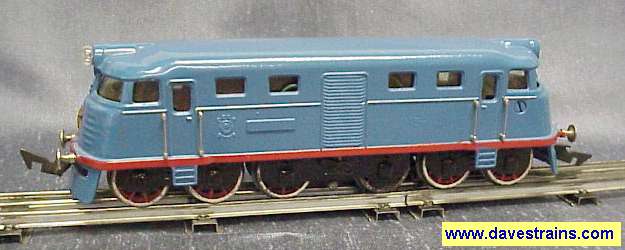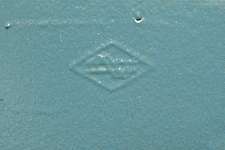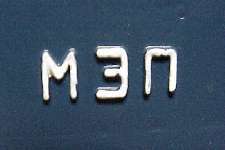www.davestrains.com
 Soviet Khrushchev-era Locomotive
Soviet Khrushchev-era Locomotive  |
|---|
| Home | Site Map | Postwar Lionel | Soviet Trains | Train Shows | Contact Us |
 Soviet Khrushchev-era Locomotive
Soviet Khrushchev-era Locomotive  |
|---|

About This Diesel Engine
A locomotive was included in every train set produced by the Soviet Union in the
1950's and 1960's. Like the Stalin-era engine, the Khrushchev-era locomotive was a diesel-type
with a 4-4-4 wheel arrangement. (The European designation is 2-B-2.) This symmetrical, die-cast
power unit measures 14 3/4 inches long (coupler to coupler), 3
inches wide and 3 3/4 inches high -- plus it weighs 6 pounds!
The unit has a 5-point star and a light on each end plus a manual reversing switch
located underneath the cab -- inside the center section of one side. (The direction of the
locomotive determines which light will be lit.) European-style bumpers front and back plus grab
rails around each of the four doors serve to enhance the beauty of the engine. Additional
decoration includes the Soviet emblem cast into the sides with "CCCP" -- Cyrillic for "USSR"
incorporated into the logo and a quarter-inch red stripe at the bottom of the cab surrounds
the entire the shell. A clear plastic window insert provides a nice finished look to the
overall appearance of the cab. The chassis has sheet-metal truck sides with black or brown
journals. The handsome spoked wheels were painted red and some engines came with the side rims
painted white.
The first Soviet locomotive was produced in 1951 and -- in addition to the decorations
described above -- had "51" (the year of introduction), Stalin's initials (in Cyrillic) and
"MEP" (in Cyrillic for the Ministry of Electrotechnical Industries) cast into the sides of the
body. Those more elaborate engines are known as
Stalin-era engines.
The Khrushchev-era engine represents a product of a changing cultural and
political environment in the USSR during the early 1960's. Consistent with Khrushchev's effort
to defame his predecessor on every level, the Soviet locomotive was stripped of its connection
to Stalin. This was accomplished by removing Stalin's initials and the number "51" from the
sides of the cab and substituting a raised blank plate. In addition, the Cyrillic initials for
the MEP were also replaced with a diamond-shaped logo on a rectangular plate. Presumably this
was done quickly by altering the original molds used to make the Stalin-era engines as it
would appear that little thought was given to changing the locomotive significantly or to
creating a brand new design.
| Photos of Khrushchev-era engines |
|---|
 |
| Above: Photo of a Blue Khrushchev-era Loco |
 |
| Above: Photo of RARE Brown Khrushchev-era Loco & Original Box |
Variations & Additional Information
Blue is the most common color for the Khrushchev-era engines. However a rare brown one
has surfaced and there may be other colors as well. In contrast to the hand-painted Stalin-era
engines, the Khrushchev-era engines were spray painted. This manufacturing change may have been
the result of the Soviets' attempt to reduce costs as they tried to sell the train sets for
profit. In addition, nickel-plated bumpers gradually replaced the earlier chemically-blackened
ones.
The original box -- which is fairly scarce -- is constructed of very soft, cardboard
material and is held together by staples. The box bottom and the separate lid are an odd,
orchid-like color that faded easily. Being even more flimsy than the box for the Stalin-era
engine, it provided even less protection than the earlier version described above. The box has
the same measurements as the Stalin-era carton: 15 1/2 inches long
by 4 inches wide by 4 1/4 inches high. Similarly, the box has no
label, printing or any other identification.
Unfortunately the Soviets discontinued the practice of stamping a serial number inside
the engine's pilot as was done for the Stalin-era sets. Instead they attached a small paper tag
to the locomotive of every Khrushchev-era set. The tag, which contained the engine's serial
number and year of production, was often lost and consequently, it may be impossible to
determine how many Khrushchev-era engines were produced. Since Khrushchev-era sets appear to be
harder to find than Stalin-era sets, it is logical to assume that fewer Khrushchev-era engines
were produced as well.
As noted above, it is unclear when the Khrushchev-era engine was first produced as the
Stalin-era engine continued to be
shown in the instruction manuals as late as August 1964 and
yet Khrushchev-era sets have surfaced with an earlier date. Although other Soviet items were
produced as late as 1969, it is likely that production of Khrushchev-era engines was halted
much earlier.
| Identifying Khrushchev-era & Stalin-era Engines | |
|---|---|
| First Row: Khrushchev Engine Markings ~ Second Row: Stalin Engine Markings | |
 |
 |
 |
 |
| Left: USSR Logos ~ Center: Blank Plate / Stalin ID + 51 ~ Right: Later ID / MEP | |

This page is an information document only; nothing on this web page is being offered for sale. This page and all of the other pages from Our Soviet Archives were developed to assist you in understanding the components of the train sets produced in the Soviet Union during the 1950's and 1960's. These sets are known today as "Stalin-era" sets and "Khrushchev-era" sets. We have used pictures from our old files and personal collection to construct this area of our website. If you are interested in buying something, please view our inventory listings to see what we currently have for sale.
This web page was last updated on September 9, 2005. If you have suggestions for improving this page or if you see any errors, please contact us.
| Trains From the SOVIET UNION | ||||
|---|---|---|---|---|
| Background: | Introduction | Component List | Archives Menu | FAQs & Glossary |
| Items For Sale: | Engines & Cars | Accessories | Other Items | Complete Sets |
| Home | Site Map | Postwar Lionel | Soviet Trains | Train Shows | Contact Us |
